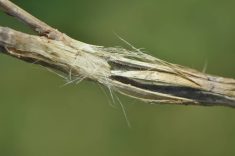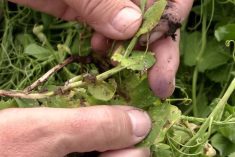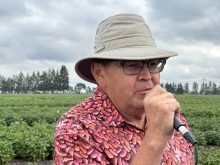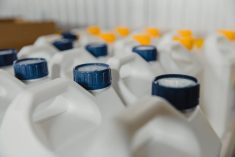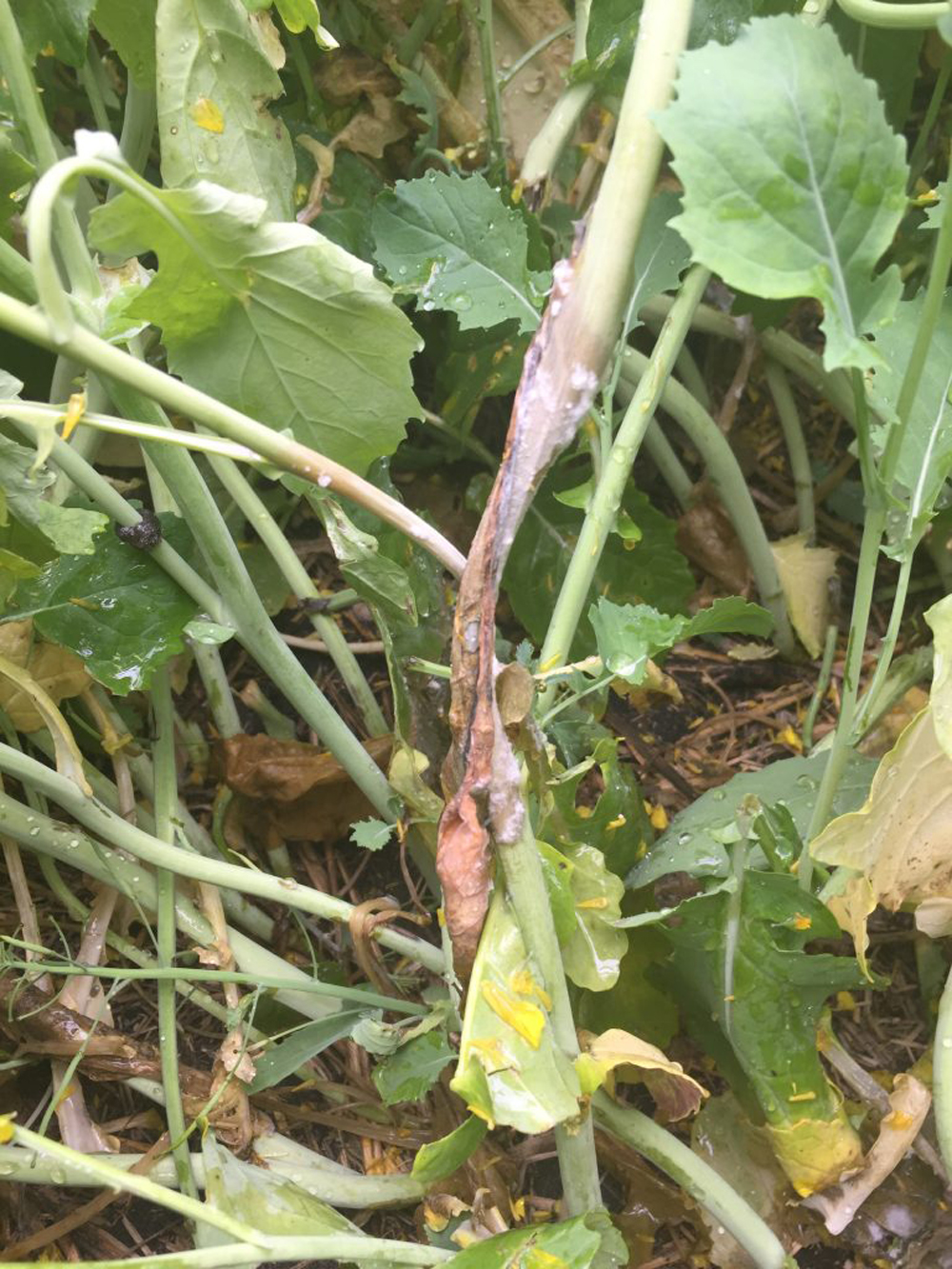Manitoba pea growers are getting a reminder of why they backed away from the crop in the first place.
Field peas, once popular in the Red River Valley, declined in the area due to disease brought on by wet weather. However, plantings jumped this year due to attractive prices. The Manitoba Agricultural Services Corporation (MASC) says farmers insured 162,078 acres of peas this year, up from almost 64,000 in 2015. Last year yields averaged about 43 bushels an acre, but this year with harvest underway yields are expected to be average, says Dennis Lange, Manitoba Agriculture’s industry development specialist for pulses.
Read Also

Manitoba sclerotinia picture mixed for 2025
Variations in weather and crop development in this year’s Manitoba canola fields make blanket sclerotinia outlooks hard to pin down
“Right now I’m saying around 35 to 40 (bushels an acre)…” Lange said during the Crop Talk Westman webinar Aug. 17.
Manitoba’s 10-year average pea yield is 40 bushels an acre, says data collected by MASC.
Excessively wet weather in parts of Manitoba hurt pea fields and have delayed, or made harvest difficult, Lange also said.
“We have seen some lodging issues and premature ripening from disease,” Lange said. “Some of the peas have gone flat and with the recent rains we’ve had, the fields are very wet and not drying out.
“Yields in the valley here, we’re probably looking anywhere from 20 to 30 bushels an acre. Out west we’re probably going to be looking more in that 35 to 40 bushels average yield.”
The wet weather has brought on mycosphaerella blight, which is part of the ascocyta disease complex, he added.
“This particular disease causes issues with things like root rot as well as leaf and stem lesions, and as well we are seeing some premature ripening,” Lange said. “It has been affecting yields to some degree this year. This particular pathogen is seed borne but also air borne and spread by rain splash… it can really affect the yield and quality of peas as well. We do have fungicide options for it, but when the disease is very prevalent some growers have had to spray twice this year.”
A fungicide should be applied at flowering and ideally before the disease is present, Lange said. A second spraying, if necessary, should follow 14 days later.
“Symptoms initially appear as small purplish-brown flecks on the leaves,” he said. “Under humid conditions they can grow large, resulting in the entire leaf being blighted out. Fungicides can be effective but sometimes disease pressure is just too severe for the fungicides to get 100 per cent control. Next year if growers are looking at growing peas again, they should use disease-free seed. Treated seed will help things along as well. Try to bury the crop residue and avoid seeding next to previous year’s pulse fields, because that disease does overwinter and can infect crops in future years.”
Farmers can improve the quality and therefore the return from their peas by taking extra care at harvest time, Lange said. A preharvest herbicide application to reduce green material in the combine can prevent seed staining, he said.
Peas are dry at 16 per cent moisture.
“The ideal (moisture for combining) is between 14 and 17 per cent,” Lange said. “That would cause the least amount of damage (due to squishing wet seeds or splitting dry ones). Once you start getting below that the splits are going to be a lot more severe.
“If you’re in that 14 to 15 per cent moisture you should still be able to harvest without too many splits. Once you start dropping down to that 11 or 12 per cent you will start seeing more splits in the sample and that’s when you will really have to start playing around with the cylinder speed and maybe raising your concave up a little tighter to force those peas through the concave a little quicker.”
Before combining ensure the combine cutter bar is sharp.
If peas are badly lodged and a flex header is not working because the ground is too wet, farmers should switch to a rake-up header if possible, because it has longer fingers that can pull in the crop, Lange said. If the farmer only has a flex header he or she might have to wait for the ground to firm up, he added.
“Keep a constant speed when you are harvesting,” Lange said. “Keep an even feed into the combine. That will make the whole process a lot easier and allow that flex header to flow along the ground. You don’t want it too rigid. If you missed a few peas that is OK, but if you put too much pressure on it you’re pulling in too much dirt as well and that’s not a good thing.”
Check the hopper for mud balls, which can smear the peas during unloading, resulting in a loss of food grade, Lange said.
Also check for harvest losses at the header and at the back of the combine and make adjustments if necessary.
“If you can limit losses to four peas per square foot (which equals about one bushel an acre) that would be great, but in some cases you might have difficulty getting to that low number,” Lange said. “It’s always good to check to see where you are at.”








